6+ Sample Risk Management Meeting Minutes
-
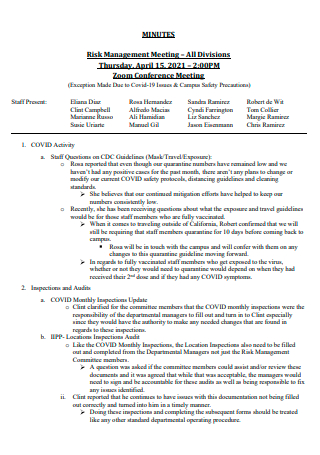
Risk Management Meeting Minutes Template
download now -
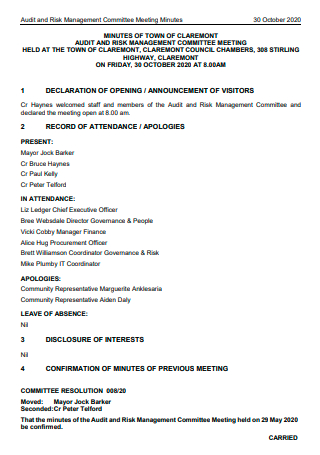
Audit and Risk Management Committee Meeting Minutes
download now -
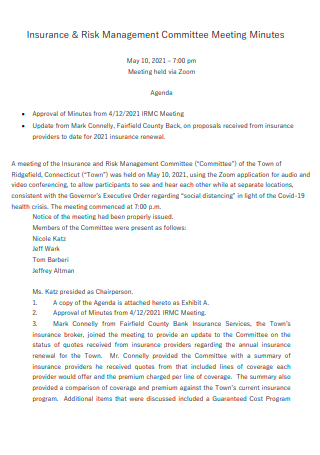
Insurance and Risk Management Committee Meeting Minutes
download now -
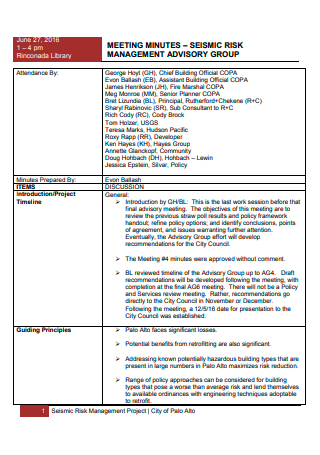
Risk Management Advisory Group Meeting Minutes
download now -
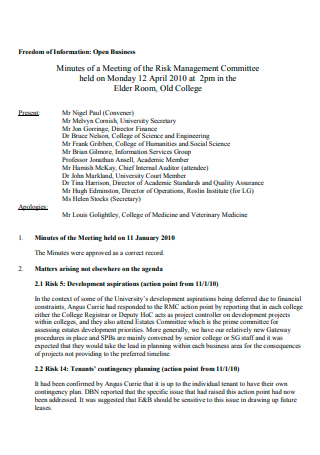
Risk Management Committee Meeting Minutes
download now -
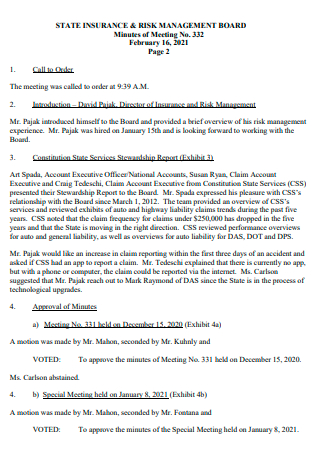
Insurance and Risk Management Board Meeting Minutes
download now -
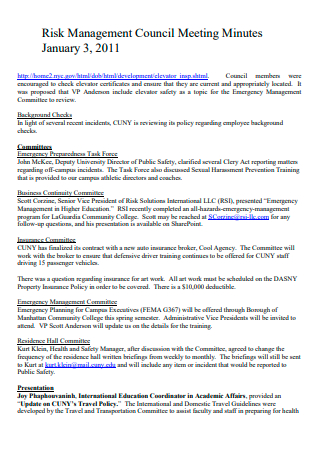
Risk Management Council Meeting Minutes
download now
FREE Risk Management Meeting Minutes s to Download
6+ Sample Risk Management Meeting Minutes
What Are Risk Management Meeting Minutes?
What’s Included in a Risk Management Meeting Minutes?
Principles of Risk Management
Steps in Making a Risk Management Meeting Minutes
FAQs
What does a business risk mean?
What is an operational business risk?
What is risk mitigation?
What Are Risk Management Meeting Minutes?
Before we get familiarized with the document, first of all, what does risk management mean? Simply put, risk management is the process of identifying, analyzing, and responding to risk factors that arise over the course of a business’s operations. Risk management also investigates the link between risks and the potential consequences for an organization’s strategic goals. The risk management process may be summarized as follows: it begins with detecting and analyzing the risk, then controlling it, and finally reviewing the controls. When the risk management process is properly executed, the organization has the chance to assess the whole spectrum of risks that it confronts, as well as the capacity to lower both the likelihood of a risk happening and its potential effect.
To have a chance of mitigating the risks that are present in the company, proactive planning is required, which can be done by holding a risk management meeting. The key decisions made in the said meeting are then noted down in its meeting minutes document, which is a business document that serves as notes that are recorded during a meeting. They are termed risk management meeting minutes in this situation because they are documented during a risk management meeting. They outline the major problems that are addressed, motions offered or voted on, and tasks to be completed to adequately manage the company’s risks. The minutes of a risk management meeting (or any other sort of meeting) is often taken by a designated member of the group, who is generally the secretary. Their job is to keep a precise description of what happened during the meeting.
What’s Included in a Risk Management Meeting Minutes?
Here are the key elements that should be typically included when tasked to write down the minutes of a risk management meeting:
Principles of Risk Management
Listed and discussed below are some of the key principles involved in the topic of risk management:
Steps in Making a Risk Management Meeting Minutes
Here are the key steps that are to be followed when a risk management meeting minutes have to be created. There may be more steps involved depending on how thorough the meeting was.
1. Pre-Planning Phase
The first step of taking down the minutes of a risk management meeting (or any type of meeting) is usually the pre-planning phase, which involves determining the meeting’s agenda. Taking minutes will be much easier if a meeting is well-planned in advance. Having said that, every important individual engaged in the risk management meeting should collaborate in advance to define the agenda. The person tasked with taking meeting minutes might collaborate with the chairman to create a document that might act as an agenda and establish the meeting format. If this is not practicable, it is the secretary’s responsibility to get a copy of the agenda even before the meeting begins.
2. Pre-Recording Phase
After the risk management meeting agenda has been determined in the pre-planning phase, the pre-recording procedure then follows. Before recording any information, a selected minutes recorder should become acquainted with the sort of material that should be recorded during the risk management meeting. This normally contains information such as the meeting’s date, time, and place, the names of attendance and absentees, a declaration of acceptance of the previous meeting’s minutes or any revisions, and the decisions made on each agenda item.
3. Writing Phase
After the pre-recording phase, the main writing process of the risk management meeting minutes will then commence. When the risk management meeting concludes, the employee entrusted with writing minutes should be provided with all of the materials he requires to write up the minutes in a clear, presentable manner. He/she should not take too long to start writing in order to keep the correctness of the facts, do a review of the earlier generated framework and make revisions as needed, and update the minutes as needed to ensure they are concise but clear.
4. Distribution Phase
The last step of noting down the risk management meeting minutes would be to distribute the document to the right people. Once the secretary has finished drafting the minutes of the risk management meeting, he or she is responsible for sharing the document with the relevant personnel, which may include group members. When it comes to disseminating the document, there are several methods to consider, such as publishing it online or over the cloud. Given the amount of paperwork that minutes and other sorts of papers might entail, it may be desirable to employ a paperless sharing technique in this phase.
FAQs
What does a business risk mean?
The concept of business risk relates to the possibility that a company will encounter events or situations that endanger its capacity to continue functioning. Business risk is anything that jeopardizes a company’s capacity to meet its financial objectives. Many things might come together to produce business risk. One of these is due to senior management incompetence within the organization. It is not the same as financial risk, which develops when a corporation has large debt that is present in its capital structure.
What is an operational business risk?
Operational business risk is a form of business risk that can occur internally, externally, or as a result of a mix of variables. Something unforeseen, such as a natural disaster or a server outage caused by technological issues, might occur, causing someone to lose their business continuity. In any case, these operational risks can cost your company money, effort, and reputation.
What is risk mitigation?
The process of planning and establishing strategies and solutions to lessen threats to project objectives is referred to as risk mitigation. It may be used to identify, monitor, and assess the risks and repercussions of completing a given project, such as the development of a new product. Risk mitigation also encompasses the activities taken to deal with concerns and the consequences of such issues in relation to a project. Risk management is a never-ending activity that evolves and develops over time. It is critical to repeat and continuously monitor the procedures since it can ensure full protection of known and undiscovered risks.
Risk management meeting minutes (or any type of meeting minutes) are especially important during a meeting since they can be used to record the important issues that were raised and key decisions to solve the said issues that were made when the meeting took place. They can be recorded manually, but in modern times, they are now usually recorded digitally. It can be an intimidating process, and it is totally understandable. But with the help of a few sample templates in this article, the process should be made easier.
